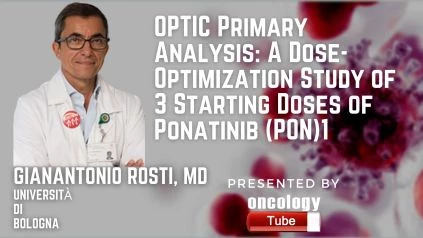Gianantonio Rosti, MD from the Università di Bologna speaks about OPTIC Primary Analysis: A Dose-Optimization Study of 3 Starting Doses of Ponatinib (PON).
S153 (Summary)
Type of Presentation: Oral
Response, resistance, and treatment-free remission in CML is the title of the session.
Backstory:
PON, a third-generation tyrosine kinase inhibitor (TKI), showed deep and long-lasting responses and survival in patients with chronic-phase chronic myeloid leukemia (CP-CML) who were resistant or intolerant to second-generation TKI therapy (PACE; NCT01207440); post-hoc analysis suggested a link between dose and both adverse events and response. The primary analysis of OPTIC (NCT02467270), a randomized, phase 2 study using a new response-based PON dosage regimen in patients with resistant/intolerant CP-CML, is presented here.
Targets:
In patients with resistant/intolerant CP-CML, assess the safety and effectiveness of ponatinib response–based dosage regimens.
Methodologies:
Pts with CP-CML resistant/intolerant to two TKIs or the BCR-ABL1 T315I mutation were randomized to PON beginning doses of 45 mg (cohort A; 45 mg 15 mg), 30 mg (B; 30 mg 15 mg), and 15 mg (C) once daily after giving informed permission. In cohorts A and B, doses were decreased to 15 mg after achieving a 1% BCR-ABL1IS. The primary goal is a 1% BCR-ABL1IS reduction after 12 months; supplementary endpoints include cytogenetic and molecular responses, as well as safety outcomes. An independent review group adjudicated AOEs prospectively.
Outcomes:
283 participants were randomly assigned to one of three groups (A/B/C: n=94/95/94) and had the following baseline characteristics: 99 percent had a resistant illness; 40% had one baseline mutation; median age 48 years (1881 years); 98 percent got two (55 percent) TKIs; 99 percent had the resistant disease; 40 percent had one baseline mutation (23 percent T315I). 134 patients (47 percent; n=50/41/43) remained on therapy at the primary analysis, with a median follow-up of 32 months, while 204 patients (72 percent) had PON exposure of fewer than 12 months. At 12 months, 44 percent (41/93) in cohort A, 29 percent (27/93) in cohort B, and 23 percent (21/91) in cohort C had reached 1% BCR-ABL1IS (Table); cohort A met the main objective. After attaining response (A/B), dose reductions to 15 mg were 48/30 percent.
Thrombocytopenia, neutropenia and anemia were the most prevalent grades 3 TEAEs, accounting for 27%, 17%, and 7%, respectively. Cohorts A (10 percent /4 percent), B (5 percent /4 percent), and C (3 percent /3 percent) reported AOEs/serious AOEs. For TEAEs (A/B/C), dose reductions or discontinuations were 46/35/32 percent and 19/16/14 percent, respectively.

